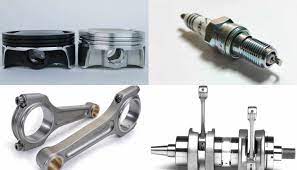Exploring the Intricacies of Motorcycle Engine Parts

The Anatomy of a Motorcycle Engine: Understanding Engine Parts
Motorcycle engines are complex machines that power these two-wheeled vehicles with precision and efficiency. Understanding the various engine parts can help riders appreciate the inner workings of their bikes and make informed decisions about maintenance and upgrades.
Cylinder Block
The cylinder block is the main component of the engine where combustion takes place. It houses the cylinders, pistons, and other critical components that drive the motorcycle.
Piston
The piston moves up and down within the cylinder block, converting energy from fuel combustion into mechanical motion. Pistons are essential for generating power in the engine.
Crankshaft
The crankshaft converts linear motion from the pistons into rotational motion, which drives the wheels of the motorcycle. It plays a crucial role in transferring power from the engine to the transmission.
Camshaft
The camshaft controls the opening and closing of valves in the engine to regulate air intake and exhaust processes. It synchronizes with the crankshaft to ensure optimal engine performance.
Valves
Valves allow air and fuel into the combustion chamber and exhaust gases out of it. Intake valves bring in fresh air-fuel mixture, while exhaust valves release burnt gases after combustion.
Spark Plug
The spark plug ignites the air-fuel mixture in the combustion chamber to initiate combustion. A properly functioning spark plug is essential for efficient engine operation.
Connecting Rods
Connecting rods link the pistons to the crankshaft, transferring linear motion into rotational motion. They play a vital role in ensuring smooth engine operation.
Understanding these key engine parts can give riders insight into how their motorcycles work and empower them to take better care of their machines. Regular maintenance, proper tuning, and timely repairs can help maximise performance and extend the life of a motorcycle’s engine.
Materials Constituting Motorcycle Engines: An Overview
Components of a Motorcycle Chassis Explained
4. Exploring the Various Parts of a Motorcycle Engine
- What is engine type in motorcycle?
- What materials are used in motorcycle engines?
- What are the parts of a motorcycle chassis?
- What are the parts of a motorcycle engine?
What is engine type in motorcycle?
When referring to the engine type in a motorcycle, it pertains to the specific design and configuration of the engine that powers the bike. Motorcycles can have various engine types, such as single-cylinder, parallel-twin, V-twin, inline-four, and more. Each engine type offers distinct characteristics in terms of power delivery, performance, fuel efficiency, and overall riding experience. Understanding the engine type of a motorcycle is crucial for riders looking to choose a bike that aligns with their preferences and riding style. Whether seeking torquey performance from a V-twin cruiser or high-revving power from an inline-four sportbike, the engine type plays a significant role in defining the personality and capabilities of a motorcycle.
What materials are used in motorcycle engines?
In motorcycle engines, a variety of materials are used to withstand the demanding conditions of combustion and mechanical stress. Common materials include aluminium for components like cylinder heads and engine blocks due to its lightweight and good heat dissipation properties. Steel is often used for crankshafts, connecting rods, and other high-stress parts for its strength and durability. Titanium may be used in valves and exhaust systems for its lightweight yet robust nature. Additionally, various alloys and composites are utilised in different engine parts to enhance performance, reliability, and longevity in the diverse operating environments that motorcycles encounter.
What are the parts of a motorcycle chassis?
The motorcycle chassis is a critical component that provides structural support and determines the handling characteristics of the bike. It consists of several key parts, including the frame, swingarm, suspension system, wheels, and brakes. The frame serves as the backbone of the chassis, holding all other components together and supporting the engine. The swingarm connects the rear wheel to the frame, allowing for suspension movement and rear wheel alignment. The suspension system includes forks at the front and shock absorbers at the rear to absorb bumps and maintain stability. Wheels provide traction and support for the bike, while brakes ensure safe stopping power. Understanding these essential parts of a motorcycle chassis is crucial for riders looking to enhance their riding experience and maintain their bikes effectively.
What are the parts of a motorcycle engine?
When exploring the components of a motorcycle engine, it becomes evident that several crucial parts work in harmony to power the vehicle. Key elements include the cylinder block, pistons, crankshaft, camshaft, valves, spark plug, and connecting rods. The cylinder block serves as the foundation where combustion occurs, while the pistons convert energy into mechanical motion. The crankshaft transforms linear piston movement into rotational force that propels the bike forward. Camshafts regulate valve operation for optimal air intake and exhaust processes. Valves control airflow in and out of the combustion chamber, with the spark plug igniting the air-fuel mixture for combustion. Connecting rods link pistons to the crankshaft to ensure smooth engine operation. Understanding these essential engine parts provides insight into how motorcycles function and underscores the importance of proper maintenance for optimal performance and longevity.
